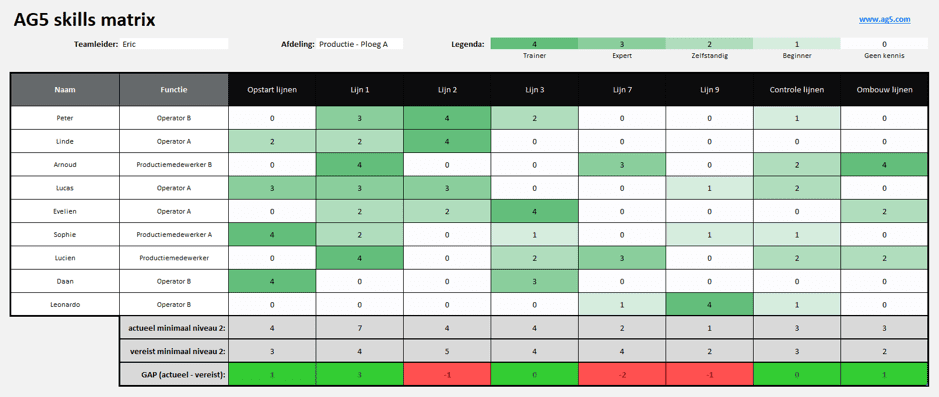An action plan for successful internal skills audits
During this article, we explain how to conduct successful internal skills audits, providing a step-by-step action plan to assess and optimize workforce competencies for organizational growth and efficiency.

A clear and concise overview of knowledge and skills is vital for any business. Having this information about your workforce readily accessible allows you to determine whether you can achieve your objectives and pinpoint any skills gaps that may need closing.
A skills audit is a great way to find out whether your employees’ knowledge, skills, and abilities are aligned with your organization’s foremost objectives. But what does an audit such as this entail exactly? And how should you conduct skills audits in practice on the shop floor?
So, what is an audit?Copied
An audit is a systematic review or assessment of a part or the whole of an organization. It may examine certain organizational processes – are they running smoothly and/or legitimately? Similarly, an audit may involve an independent examination of important financial information, such as annual accounts, subsidy requests, or reports.
There are many types of audit:
- financial
- forensic (fraud investigation)
- qualitative (safety/sector standards compliance)
- operational (process inspection)
- IT
Audits can be performed either internally or externally. Internal audits are performed by auditors employed inside the organization. External audits are performed by independent auditors from outside the organization.
But what is a skills audit?Copied
A skills audit is a special type of audit, focusing primarily on mapping your employees’ knowledge, skills, and abilities. They’re mainly internal.
Generally speaking, skills audits comprise three steps:
- Step 1: Identify and define the skills and abilities most critical to your organization. For example, a software company can’t operate with staff without highly developed IT skills, whereas a communications agency needs people with strong verbal and written communication skills, who can convey information clearly and concisely.
- Step 2: Evaluate and map your employees’ current knowledge, skills, and abilities. Have you got all your bases covered in terms of essential skills and core competences?
- Step 3: Now you know what your employees are capable of, you can pinpoint any serious skills gaps. Using this information, you’ll be better positioned to analyze, design, and optimize your training programs.
Tip: Below, you’ll find a comprehensive action plan for conducting an internal skills audit.
The benefits of internal skills auditsCopied
Internal skills audits provide many benefits. Below, you’ll find a few of the most important ones.
- Skills audits help you clearly and concisely determine whether you’ll be able to achieve your organization’s objectives with your current workforce.
- Without access to this information about your employees, it’ll be incredibly difficult to make tangible improvements. Audits also help you pinpoint any bottlenecks or vulnerabilities, but also clear directives as how to respond.
- Taking the outcome of these audits, you can improve the quality and effectiveness of your training programs. It’s challenging to design training courses and workshops to meet both individual employees’ needs and requirements and those of the organization as a whole. Forget inefficient and broad-based training programs! Focus on training specific skills that benefit both individuals and the company, instead!
- Skills audits also provide the information you need for your recruitment efforts, because they force you to define and focus on candidates’ profiles, thereby increasing the chances of finding the right people.

Conducting skills audits on the shop floorCopied
The best way to conduct a skills audit is to use and follow a clear action plan – step by step. It’s high time we looked at the steps involved in getting the most out of your skills audits.
1. Define the roles within your organization
Start by mapping all the roles within your organization. This isn’t the same as merely listing all the job titles you use.
Roles relate to skills and competences relevant to one or more jobs. For example, it’s highly likely that a customer service manager and customer service agent share many of the same skills. The same would apply to an accountant and financial controller.
2. Define the skills required in each role
Once you’ve clearly defined the roles within your organization, it’s sensible to then determine which of these are essential and which are desirable. What kinds of skills are most prevalent? Are they primarily technical/specialist skills? Or do personality traits also play a role?
3. Conduct a quick survey
The role or job that an employee performs doesn’t say everything about all of his or her skills and competences. They may have relevant skills that they scarcely, if ever, use in their current role or job.
A short survey, designed to allow employees to respond quickly and easily and covering all the roles within your organization, can provide you additional information about hidden skill sets.
Communicate clearly to everyone why you’re conducting the survey and what you’ll be doing with the answers.
4. Process and analyze results
If all went well, you now have a wealth of information about your employees’ knowledge, skills, and abilities. Now it’s key that you use this information intelligently by processing and analyzing it properly.
Make sure that you compile your data from two distinct perspectives – listing the skills each employee has and listing the employees for each skill.
Other important insights you can gain from conducting skills audits include:
- skills gaps within a certain role
- skills gaps within teams, departments, or business units
- potential successors in certain roles
- numbers of employees with business-critical skills
- future skill requirements

Tip: present results using a skills matrixCopied
A skills matrix is an ideal way to present the results of your internal skills audit, i.e. an overview of employees and their skills.
Using skills matrices has many benefits.
- We’re visually oriented beings, and skills matrices are an ideal way to visualize this information. Everyone can see at a glance what they’re capable of – individual employees and managers alike.
- Skills matrices give you greater insights into critical skills and requirements and form a solid basis for training and recruitment policies.
- They also make finding replacements or extra personnel a lot easier during peak periods, as they provide a clear picture of who can do what.
- You can use skills matrices at any level – team, departmental, or organizational.
- What’s more, if you keep your matrices up to date, they allow you to see the progress individuals or teams are making in terms of professional development, productivity, or skill set growth.
Option 1: Skills matrices using Excel
Many companies use spreadsheets such as MS Excel for this purpose. Doing so is certainly an option, because this application allows you to build the basic components of a skills matrix.
However, Excel has numerous disadvantages and pitfalls. Spreadsheets can also become overly complex and are extremely prone to error. Version management is also a potential pitfall, certainly when more than one employee needs access to the spreadsheet to make updates and subsequently emails his or her colleagues a copy. Before you know it, no one knows who has the latest version or where they saved it.
If you’d like to start using skills matrices, but aren’t sure how, then download our skills matrix templates to get you up and running.
Option 2: Skills management software
Although Excel is a great way to get to grips with skills management, we recommend opting for a special-purpose solution for the longer term. A prime example is AG5’s skills management software.
Our solution gives you the option to update employees’ skills, competences, and qualifications from the work floor in real time. What’s more, all your data is safely and securely stored in a central location.
Watch our explainer video to see how it works:
Many companies are already using our software and have come to the realization that it’s the ideal way to create clarity about the skills existing within their organizations.
Curious about what AG5 could do for you? Read how it works or schedule a live demo.
Use AG5 to identify skill gaps
Say goodbye to Excel matrices. Start using AG5’s plug and play skill matrix software.
ISO27001 certified
Start your 14-day free trial
Let’s audit!Copied
An internal skills audit helps you gather valuable information about your employees’ knowledge, skills, and abilities. It pinpoints the existence or absence of skills critical to your organization’s operations and allows you to tailor your training and recruitment policies to current needs and requirements. Let’s audit!


